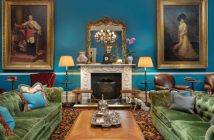The Duomo dominates the Florentine skyline, a great terracotta balloon rising to the clouds. Curiously, though, you’ll find the city’s pantheon of ‘Renaissance Men’ buried beneath it; for their resting place, you’ll need to head half a mile south-east,until the patterned marble face of Santa Croce stands before you. Michelangelo is buried here, as is Machiavelli, Leon Battista Albertiand Galileo, along with the empty sarcophagus of Dante(exiled from Florence, his body lies in Ravenna). Being laid to rest in this vast Franciscan church is the historic Florentine equivalent of having a star set on Hollywood Boulevard.
Befitting its A-list inhabitants, the church’s interior artworks are dazzling: wall after all of Giotto frescoes, sculptures by Donatello in stone and bronze, and the oldest example of Florentine stained glass.
Just like the Duomo, Santa Croce was originally designed by architect Arnolfo di Cambio in the 13thcentury. They have rather similar ornate, colourful facades, with the soaring geometricity and flattened stage-set quality of Italian Gothic, and both had subsequent generations revised or completed parts of the structure, so today they stand as a sort of palimpsests of Florentine architectural history. Yet Santa Croce perpetually in the shadow of its better-known, domed neighbor. The same goes for the whole neighbourhood of Santa Croce, in fact, which despite its many historic gems, retains more of an authentically local, livable feel than around the Uffizi and Piazza della Repubbublica.

Behind the austere, rusticated walls (this type of chunky masonry was associated withpower and strength in Renaissance architecture)and shuttered windows of Santa Croce’s palazzi, you’ll find the Bargello Museum, which specialises in Renaissance sculpture; Casa Buonarroti, housing Michelangelo’s early marble reliefs and drawings; and one of the city’s oldest libraries, Biblioteca Nazionale Centrale.Also, a member of Italy’s esteemed Baglioni group of hotels: Relais Santa Croce.
There’s little hint what to expect inside when approaching the hotel’s plant-adorned entranceway; the reception is up on the ‘piano nobile’, or first floor. It’s all the more impressive, then, when you stroll into the lofty communal rooms beyond the check-in desk – particularly the Sala della Musica, an ornate ballroom featuring a three-metre chandelier. Delicate frescoes, gilded mirrors and hand-sculpted reliefs are lavished upon the walls throughout, carefully preserved fromthe 18thcentury, when Marchese Baldinucci, a powerful treasurer to the Pope,called the place home.
In its latter-day life as a 24-room, five-star hotel, Baglioni Relais Santa Croce preserves the grandeur and comfort of an aristocratic private residence, minus the stuffiness. The ballroom, for example, functions as a relaxed piano lounge serving aperitivo to guests seated in squashy leather couches (keep your eyes peeled for the hidden wall panels – once upon a time, musicians to play from behind these to fill the room with mysterious music).

Bedrooms and suites are decked out in elegant cream and black – classic rather than overtly antique in styling – with touches of crimson in form of armchairs and lamps. Even in an ‘entry-level’ deluxe room, you can count on having a spacious Tuscan marble en-suite complete with Turkish steam bath (the perfect way to soothe jet lag, I found), while the Da Verrazzano Royal Suite boasts its own gym and Jacuzzi.
A fusion of traditional and contemporary is also found in the hotel’s restaurant, Guelfi e Ghibellini. Seasonal Tuscan cuisine, referencing the region’s simple rustic dishes, is presented with innovative modern flair by chef Niccolo de Riu. There is also a stand-alone Michelin-starred restaurant handily located on the ground floor of the property, named Enoteca Pinchiorri.

Along Santa Croce’s narrow streets, lined with leather artisan workshops, it’seasy to imagine Machiavelli plotting from that balcony, or Leonardo’s pencil point skittering across a sheet of paper inside that studio… Yet for all its tangible history, there certainly isn’t a somber museum atmosphere around here. After dark, locals flock to the lively wine bars that line Piazza Santa Croce and the lanes branching off it. Via dei Benci and Via Panisperna are the places to head at aperitivo time, then night owls can continue the party around Mercato di Sant’Ambrogio and Piazza dei Ciompi.
Regardless of when you stagger up the stone stairs of your palazzo, the best way to start another day of exploring the ‘Cradle of the Renaissance’ is to nab the balcony table in Guelfi e Ghibelliniand order a silver pot of Italian coffee and an Eggs Florentine – I learn that the dish’s name is a salute to Catherine de Medici, who introduced spinach to France after her marriage to Henri II. It turns out that in Florence breakfast no different banking or art, then, in that there is probably a Medici somewhere behind it.
Baglioni Relais Santa Croce, Florence is available from €250 per night on a B&B basis. For booking and further information, please visit www.baglionihotels.com or call +39 05 50621908.




